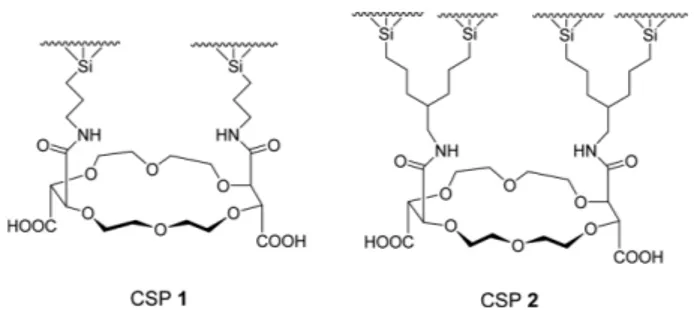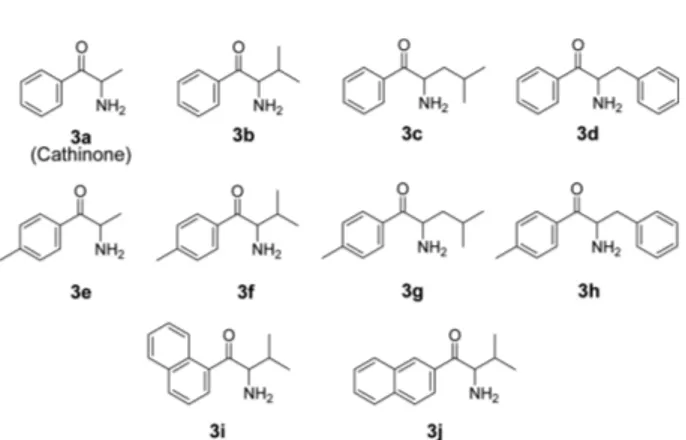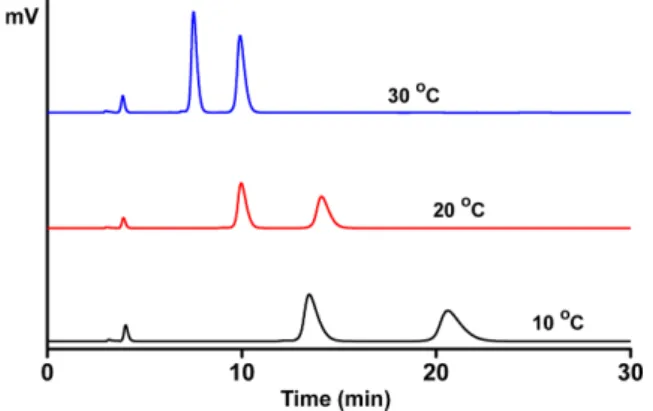Printed in the Republic of Korea
http://dx.doi.org/10.5012/jkcs.2011.55.5.751
Resolution of Aryl α-Aminoalkyl Ketones on a Doubly Tethered Liquid Chromato- graphic Chiral Stationary Phase Based on (+)-(18-Crown-6)-2,3,11,12-
tetracarboxylic Acid
Kab Bong Jin, Hee Jin Kim and Myung Ho Hyun*
Department of Chemistry and Chemistry Institute for Functional Materials, Pusan National University, Pusan 609-735, Korea. *E-mail: mhhyun@pusan.ac.kr
(Received June 17, 2011; Accepted July 28, 2011)
ABSTRACT. A doubly tethered chiral stationary phase (CSP) based on (+)-(18-crown-6)-2,3,11,12-tetracarboxylic acid was applied to the resolution of various aryl α-aminoalkyl ketones with the use of 80% ethanol in water containing 10 mM sulfuric acid as a mobile phase. The chiral resolution was quite successful, the separation factors (α) and the resolutions (RS) being in the range of 1.39-2.05 and 3.18-5.22, respectively. The separation factors (α) on the doubly tethered CSP were slightly worse than those on the corresponding singly tethered CSP. However, the resolutions (RS) on the doubly tethered CSP were generally greater than those on the corresponding singly tethered CSP. The chromatographic behaviors for the resolution of aryl α-aminoalkyl ketones on the doubly tethered CSP were demonstrated to be dependent on the type and the content of the organic and acidic modifiers in aqueous mobile phase and the column temperature.
Key words: Aryl α-aminoalkyl ketone, Chiral stationary phase, (+)-(18-Crown-6)-2,3,11,12-tetracarboxylic acid, Liquid chro- matography, Resolution
INTRODUCTION
Liquid chromatographic chiral stationary phase (CSP 1, Fig. 1) prepared by covalently bonding (+)-(18-crown-6)- 2,3,11,12-tetracarboxylic acid to aminopropylsilica gel was very successful in the resolution of various racemic primary amino compounds including α- and β- and γ- amino acids,1-3 racemic amines and amino alcohols,4 flu- oroquinolone antibacterial agents,5 and tocainide (anti- arrhythmic agent) and its analogues.6 For the chiral rec- ognition of primary amino compounds on CSP 1, the enantioselective complexation of the primary ammonium ions (R-NH3+) of analytes inside the cavity of the crown ether ring of the stationary phase has been known to be essential and consequently, acidic modifier was usually added to aqueous mobile phase to protonate the primary amino group of analytes.1-6 Under the acidic mobile phase condition, the stability of CSP 1 was not ensured. In order to improve the stability of CSP 1, CSP 2 (Fig. 1) was pre- pared by adding a second tethering group to silica gel through a carbon atom of the first tethering group of CSP 1.7 CSP 2 was found to show higher stability than CSP 17 and, additionally, CSP 2 was found to be generally greater than CSP 1 in the resolution of α-amino acids,7 amines,7 amino alcohols.7 β-amino acids,8 and tocainide (anti- arrhythmic agent) and its analogues.9
Aryl α-aminoalkyl ketones (3, Fig. 2) belong to an interesting family of biologically active chiral com- pounds. For example, the (S)-enantiomer of α-aminopro- piophenone (3a) named as cathinone is a psychoactive alkaloid found in the leaves of the khat plant and, con- sequently, it has attracted forensic attention.10 Aryl α- aminoalkyl ketones (3) including racemic cathinone have been successfully resolved on CSPs based on (3,3’- diphenyl-1,1’-binaphthyl)-20-crown-6.11-13 CSP 1 was also successful in the resolution of aryl α-aminoalkyl ketones (3) including racemic cathinone.14 However, CSP 2 has not been applied to the resolution of aryl α- aminoalkyl ketones (3). In this report, we wish to dem- onstrate that CSP 2 is also effective for the resolution of aryl α-aminoalkyl ketones (3) especially in terms of the resolutions (RS).
Fig. 1. Structures of CSP 1 and CSP 2.
EXPERIMENTAL
Chromatography was performed with an HPLC system consisting of a Waters Model 515 pump, a Rheodyne Model 7725i injector with a 20 µl sample loop, a Youngin M 720 Absorbance detector (variable wavelength) and a YoungLin Autochro Data Module (Software: YoungLin Autochro-WIN 2.0 plus). Column temperature was con- trolled by using a Julabo F30 Ultratemp 2000 cooling cir- culator. The chiral column (150 mm × 4.6 mm I.D.
stainless steel column) packed with CSP 2 were available from the previous study.7 Racemic and optically active cathinone and aryl α-aminoalkyl ketones (3) prepared from corresponding racemic and optically active α-amino acids were available from the previous study.14
RESULTS AND DISCUSSION
Aryl α-aminoalkyl ketones (3) were resolved on CSP 1 with the use of 80% ethanol in water containing 10 mM sulfuric acid as a mobile phase.11 In order to compare the chiral recognition efficiency of CSP 2 with that of CSP 1, aryl α-aminoalkyl ketones (3) were resolved on CSP 2 under the identical mobile phase condition. The chro- matographic resolution results on CSP 2 are summarized and compared to those on CSP 1 in Table 1.
The retention times of the first eluted enantiomers denoted by the retention factors (k1) on CSP 2 were always greater than those on CSP 1 as shown in Table 1. The improved lipophilicity of CSP 2 originated from the sec- ond tethering group is expected to increase the lipophilic interaction between the CSP and the analytes under reversed mobile phase condition. In this instance, the retention of the analytes on CSP 2 should be greater than that on CSP 1. Another interesting result to note is the fact
that the retention factors on CSP 1 and CSP 2 are depen- dent quite much on the size of the alkyl group at the chiral center of analytes. When the alkyl group at the chiral cen- ter of analytes is methyl (3a and 3e), the retention factors are largest on both CSP 1 and CSP 2. However, when the alkyl group at the chiral center of analytes is changed from methyl to isopropyl (3b and 3f), the retention factors are reduced significantly on both CSP 1 and CSP 2. The enan- tioselective complexation of the primary ammonium ions (R-NH3+) of analytes inside the cavity of the crown ether ring of the stationary phase might be hindered by the ster- ically large isopropyl group at the chiral center of analytes and consequently, the retention factors are expected to be reduced. When the alkyl group at the chiral center of ana- lytes is changed from isopropyl to isobutyl (3c and 3g) and then to benzyl (3d and 3h), the retention factors are increased on both CSP 1 and CSP 2. Especially, the reten- tion factors for analytes 3d and 3h are increased quite much. The isobutyl group is expected to be sterically less demanding than the isopropyl group because the steri- cally large isopropyl moiety of the isobutyl group is remote from the chiral center by one methylene unit. In addition, the isobutyl group is more lipophilic than the isopropyl group. Consequently, the retention factors for analytes 3c and 3g should be greater than those for ana- lytes 3b and 3f. The benzyl group at the chiral center of analytes 3d and 3h is expected to be sterically much less demanding than the isobutyl group because of the flat nature of the phenyl moiety. In this instance, the retention Fig. 2. Structures of aryl α-aminoalkyl ketones 3 used in this
study.
Table 1. Comparison of the resolution of aryl α-aminoalkyl ketones 3 on CSP 1 and CSP 2 with the use of 80% ethanol in water containing sulfuric acid (10 mM) as a mobile phase.a
Analyte CSP 1 CSP 2
k1’b αc RSd k1’b αc RSd
3a 1.23 (S) 1.48 1.47 8.11 (S) 1.38 3.08 3b 0.11 (S) 2.12 2.13 1.85 (S) 1.73 3.73 3c 0.34 (S) 1.95 3.11 3.70 (S) 1.55 4.00 3d 1.03 (S) 1.55 3.55 8.30 (S) 1.36 3.15 3e 1.22 (S) 1.55 2.80 8.08 (S) 1.40 3.64 3f 0.16 (S) 2.08 1.89 2.30 (S) 1.59 3.86 3g 0.31 (S) 1.99 2.88 3.75 (S) 1.55 4.57 3h 0.86 (S) 1.58 3.09 8.00 (S) 1.36 2.90 3i 0.25 (S) 2.20 3.87 2.48 (S) 2.13 4.42 3j 0.26 (S) 2.19 3.77 2.92 (S) 1.95 5.83
aThe chromatographic data on CSP 1 were quoted from Reference [11]. Flow rate: 0.5 ml/min, Detection: 210 nm UV, Temperature:
20oC. bRetention factor of the first eluted enantiomer. The abso- lute configuration of the first eluted enantiomer was presented in the parenthesis. cSeparation factor. dResolution.
factors for analytes 3d and 3h should be quite long. In contrast, the effect of the size or lipophilicity of the aryl group of analytes 3 on the retention times is not so sig- nificant. As the lipophilicity of the aryl group of analytes is increased, the retention times were found to increase only slightly (see 3b, 3f, 3i and 3j in Table 1). The sep- aration factors (α) on CSP 2 are slightly worse than those on CSP 1. However, the resolutions (RS) on CSP 2 are much greater than those on CSP 1 except for the analytes (3d and 3h) containing benzyl substituent at the chiral center. Even though the reason is not clear, the improved lipophilicity of CSP 2 might be responsible for the slightly diminished separation factors and the significantly improved resolutions on CSP 2 compared to those on CSP 1.
As an effort to elucidate the chiral recognition behav- iors for the resolution of aryl α-aminoalkyl ketones (3) on CSP 2, three selected analytes (3a, 3e and 3f) were resolved on CSP 2 with the variation of the type and the content of organic and acidic modifiers in aqueous mobile phase and with the variation of column temperature.
The chromatographic resolution results with the varia- tion of the type and the content of organic modifiers in aqueous mobile phase containing 10 mM sulfuric acid are summarized in Table 2. Among three different organic modifiers including acetonitrile, methanol and ethanol, ethanol is most effective in terms of the separation factors and the resolutions for the resolution of 3a and 3e. How- ever, the three organic modifiers are almost equally effec- tive for the resolution of 3f. When the content of ethanol in aqueous mobile phase was decreased, all of the three chro- matographic parameters including the retention factors, separation factors and resolutions decreased significantly.
Fig. 3 demonstrates the significant decrease in the reten- tion factor, separation factor and resolution for the reso- lution of 3a on CSP 2. As the content of ethanol in aqueous mobile phase is decreased, the polarity of the mobile phase is expected to increase and, consequently, the polar
interaction between the analyte and the mobile phase might increase. In this instance, the retention factors should decrease as the content of ethanol in aqueous mobile phase is decreased. However, the trends of the separation factors and the resolutions with the variation of the con- tent of ethanol in aqueous mobile phase are not clear.
The chromatographic results for the resolution of selected analytes (3a, 3e and 3f) on CSP 2 with the variation of the type and the content of acidic modifier in 80% ethanol in water are summarized in Table 3. Even though each of perchloric acid, trifluoroacetic acid and sulfuric acid was useful as an acidic modifier, sulfuric acid was found to be generally better than the other two acids in terms of the separation factors and the resolutions. However, the rea- son is not clear yet. When the content of sulfuric acid was decreased from 10 mM to 5 mM and then to 1 mM, the retention factors increased significantly while the sepa- ration factors and resolutions decreased only slightly. The representative chromatograms for the resolution of 3f on CSP 2 with the variation of the content of sulfuric acid in 80% ethanol are presented in Fig. 4. As the content of sul- furic acid in aqueous mobile phase is decreased, the ionic
Table 2. Resolution of selected aryl α-aminoalkyl ketones (3a, 3e and 3f) on CSP 2 with the variation of the type and the content of organic modifier in aqueous mobile phase containing 10 mM sulfuric acid.a
Organic modifier in water
3a 3e 3f
k1 α RS k1 α RS k1 α RS
80% CH3CN 2.76 1.16 1.73 2.69 1.22 3.13 0.69 1.55 3.88
80% CH3OH 5.28 1.26 2.36 5.25 1.29 2.90 1.06 1.62 3.71
80% CH3CH2OH 8.11 1.38 3.08 8.08 1.40 3.64 2.30 1.59 3.86
50% CH3CH2OH 4.76 1.23 1.54 5.27 1.23 1.85 1.99 1.29 1.78
30% CH3CH2OH 4.59 1.09 0.44 4.23 1.09 0.52 1.59 1.13 0.81
aFlow rate: 0.5 ml/min. Detection: 254 nm UV. Column temperature: 20oC. k1: Retention factor of the first eluted enantiomer. α: Separation factor. RS: Resolution.
Fig. 3. Chromatograms for the resolution of 3a (cathinone) on CSP 2 with the variation of methanol content in water containing 10 mM sulfuric acid as a mobile phase. Flow rate: 0.5 ml/min.
Detection: 254 nm UV. Column temperature: 20oC.
strength of the mobile phase is expected to decrease. In this instance, the polar interaction between the mobile phase and the analyte decreases and, consequently, the retention of the analyte should increase.
The effect of the column temperature on the resolution of three selected analytes (3a, 3e and 3f) on CSP 2 is sum- marized in Table 4. As the column temperature is increased, the retention factors decrease quite much. The decreasing trends of the retention factor for the resolution of 3f on CSP 2 are well demonstrated in Fig. 5. As the col- umn temperature is increased, the formation of the dias- tereomeric complex of the analyte inside the cavity of the crown ether ring of the stationary phase will become less
effective and, consequently, the retention factors should decrease. In contrast, the separation factors and the res- olutions did not change significantly with the variation of the column temperature.
In summary, CSP 2 prepared by introducing the second tethering group into the corresponding singly tethered CSP (CSP 1) was applied to the resolution of aryl α-ami- noalkyl ketones. CSP 2 was found to be generally greater than CSP 1 in terms of the resolutions (RS), but the former was slightly worse than the latter in terms of the separa- tion factors (α). In addition, CSP 2 was found to show greater retention factors (k1) than CSP 1. The improved lipophilicity of CSP 2 was proposed to be responsible for Fig. 4. Chromatograms for the resolution of 3f on CSP 2 with
the variation of sulfuric acid content in 80% ethanol in water as a mobile phase. Flow rate: 0.5 ml/min. Detection: 254 nm UV.
Column temperature: 20oC.
Table 3. Resolution of selected aryl α-aminoalkyl ketones (3a, 3e and 3f) on CSP 2 with the variation of the type and the content of acidic modifier in 80% ethanol in water as a mobile phase.a
Mobile phase 3a 3e 3f
k1 α RS k1 α RS k1 α RS
10 mM HClO4 9.01 1.32 2.30 8.42 1.35 2.79 2.26 1.56 3.64
10 mM CF3COOH 7.43 1.37 2.50 7.09 1.39 2.71 2.08 1.53 3.03
10 mM H2SO4 8.11 1.38 3.08 8.08 1.40 3.64 2.30 1.59 3.86
5 mM H2SO4 11.45 1.37 2.63 11.02 1.39 3.11 3.20 1.55 3.38
1 mM H2SO4 26.99 1.35 2.12 25.88 1.38 2.57 8.25 1.41 2.64
aFlow rate: 0.5 ml/min. Detection: 254 nm UV. Column temperature: 20oC. k1: Retention factor of the first eluted enantiomer. α: Separation factor. RS: Resolution.
Table 4. Resolution of selected aryl α-aminoalkyl ketones (3a, 3e and 3f) on CSP 2 with the variation of the column temperature in 80%
ethanol in water containing 10 mM sulfuric acid as a mobile phase.a Column
temperature
3a 3e 3f
k1 α RS k1 α RS k1 α RS
10 oC 13.81 1.40 2.72 12.71 1.44 3.11 3.45 1.68 3.88
20 oC 8.11 1.38 3.08 8.08 1.40 3.64 2.30 1.59 3.86
30 oC 1.64 1.35 3.13 4.85 1.38 3.30 1.49 1.53 3.20
aFlow rate: 0.5 ml/min. Detection: 254 nm UV. k1: Retention factor of the first eluted enantiomer. α: Separation factor. RS: Resolution.
Fig. 5. Chromatograms for the resolution of 3f on CSP 2 with the variation of the column temperature. Mobile phase: 80% eth- anol in water containing 10 mM sulfuric acid. Flow rate: 0.5 ml/
min. Detection: 254 nm UV.
the greater retention factors. The chromatographic behav- iors for the resolution of aryl α-aminoalkyl ketones on CSP 2 were demonstrated to be dependent on the type and the content of organic and acidic modifiers in aqueous mobile phase and the column temperature.
Acknowledgements. This work was supported for two years by Pusan National University Research Grant.
REFERENCES
1. Hyun, M. H.; Jin, J. S.; Lee, W. J. Chromatogr. A 1998, 822, 155.
2. Hyun, M. H.; Cho, Y. J.; Jin, J. S. J. Sep. Sci. 2002, 25, 648.
3. Lee, S. J.; Cho, H. S.; Choi, H. J.; Hyun, M. H. J. Chro- matogr. A 2008, 1188, 318.
4. Hyun, M. H.; Jin, J. S.; Koo, H. J.; Lee, W. J. Chro- matogr. A 1999, 837, 75.
5. Hyun, M. H.; Han, S. C.; Jin, J. S.; Lee, W. Chromatographia 2000, 52, 473.
6. Hyun, M. H. Min, H. J.; Cho, Y. J. Bull. Kor. Chem. Soc.
2003, 24, 911.
7. Hyun, M. H.; Song, Y.; Cho, Y. J.; Kim, D. H. J. Chro- matogr. A 2006, 1108, 208.
8. Hyun, M. H.; Song, Y.; Cho, Y. J.; Choi, H. J. Chirality 2008, 20, 325.
9. Kim, H. J.; Choi, H. J.; Hyun, M. H. Bull. Kor. Chem.
Soc. 2010, 31, 687.
10. Lurie, I. S.; Klein, R. F. X.; Cason, T. A. D.; Lebelle, M.
J.; Brenneisen, R.; Weinberger, R. E. Anal. Chem. 1994, 66, 4019.
11. Aboul-Enein, H. Y.; Serignese, V. Biomed. Chromatogr.
1997, 11, 7.
12. Hyun, M. H.; Tan, G.; Cho, Y. J. Biomed. Chromatogr.
2005, 19, 208.
13. Choi, H. J.; Jin, J. S.; Hyun, M. H. J. Chromatogr. B 2008, 875, 102.
14. Hyun, M. H.; Tan, G.; Cho, Y. J. J. Liq. Chromatogr. Rel.
Technol. 2004, 27, 1671.



